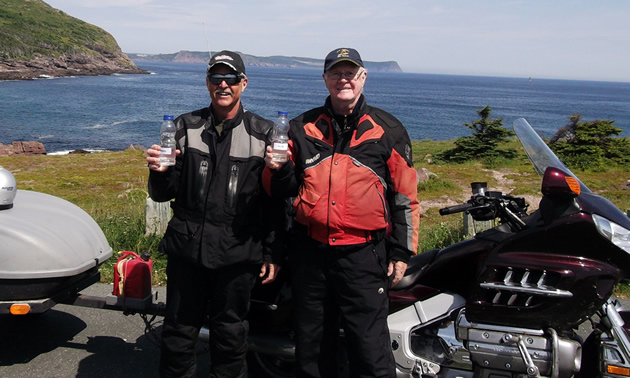My adolescence was split between New Brunswick and my birth province of Prince Edward Island. As we exited Quebec and entered New Brunswick, I became somewhat euphoric. The temperature soared to a high of 33º C and that feeling of being hurried on a main highway left me.
Familiar territory
As we rode through the northwestern part of New Brunswick, we could see the Appalachian Mountains and smell the forests, farmers' fields and the St. John River. We stopped in Hartland to check out the World's Longest Covered Bridge because I needed to take Bruce through it on the bike.
We continued east enjoying the sight of the river valley, crops, forests and I think a glimpse of the Mactaquac headpond, which feeds a large hydroelectric plant. We travelled along the old highway—the one I travelled as a child along the St. John River—east of the capital city of Fredericton. As we neared our stop for the day, we passed a convoy of wide, over-length trucks with their pilot vehicles. Their cargo was massive; it was those blades that are used on the windmill farms. After casually glimpsing the windmills off in the distance in a field, I was impressed by how gigantic the blades truly are. Sackville, New Brunswick, was to be a motel day, some 775 kilometres since leaving our start in Quebec.
Within sight of our goal
We were now within spitting distance of The Rock—a measly 400 kilometres away. After a quick half-an-hour ride east, we arrived at the border between New Brunswick and Nova Scotia, which is an area known as the Tantramar Marsh. There was a huge wind farm littered with windmills with what I suspect had the same blades that we saw being transported on the highway. I now have a new appreciation for that technology.
Since leaving Vancouver Island what felt like an eternity ago, but in reality just 11 days previously, the marshes would be my second taste of salt air off the ocean—but this time, it was from the Atlantic. We meandered along the Trans-Canada Highway, enjoying the scenery with its rolling hills, the Cobequid Mountains, small communities, glimpses of the ocean and sunshine with a temperature of 32º C. As we neared the Canso Causeway, which is the bridge that links Nova Scotia to Cape Breton Island, I could taste the salt air. The local fishery processing smells seemed everywhere as well. The Atlantic Ocean looked prominent and it seemed within view from every angle.
Riding up a mountain
As we neared our goal—the ferry terminal for the Newfoundland Ferry in North Sydney—we felt a need to climb to the top of Kelly Mountain. We stopped up top for a view of the Seal Island Bridge crossing the Bras d'or Channel. What goes up must come down and the ride down Kelly Mountain was slow and necessitated a switchback corner. The smell of fresh rain greeted us at the bottom.
We arrived early for the ferry, necessitating a four-hour wait—which gave us lots of time to explore. The passenger lounges are inviting—they serve food, there are movies playing and showers for truckers and those who are road weary. Inside the lounge was a sign that caught my eye and puzzled me. The "Flat Earth Society" identified our location at North Sydney as "one of the four corners of the world." This is certainly worth a Google search.
A pleasant ferry ride
Motorcycles—which are separated from the other ferry traffic—are often afforded priority loading and moved on board as a group. The ferry ride takes approximately six hours from loading to the time of unloading and it crosses the unpredictable Atlantic Ocean. Tie-downs are provided to secure your ride to prevent it from tipping over.
The ship seemed new and the passenger lounges modern with all the amenities of a big jetliner—even necessitating headphones for the many flat screens. The chairs were high-back recliners, which allowed us to snooze on this night crossing. Cabins are available at extra cost and for those who make reservations.
We arrived at 6:30 a.m. and it was sunny with a temperature of 11º C. I hurried outside to enjoy the view of our port of entry, Channel-Port-aux Basques, from the observation deck on the ship; it was beautiful. There was only one more hurdle and 900 kilometres to our goal, Cape Spear.
Taking it all in
The nickname, The Rock, became obvious as we rode northeast through the Anguille Mountains to the west and the long Range Mountains to the east. The geography was vast, rugged and there seemed to be rock everywhere.
The highway was deserted after all of the ferry traffic passed us. As we went by Deer Lake and into the Humber Valley region, we slowed to a near stop and rode on the opposite side of the highway to cautiously pass a cow and calf moose in the ditch.
The people of Gander opened their hearts and homes to many stranded air passengers during the terrorist attack on the World Trade Center on September 11, 2001. We stopped at the aviation museum there to reflect on this event and take a break. We spent the night in Clarenville before our final push to Cape Spear. On this day we logged 745 kilometres.
Reaching our goal
We were quietly excited as there was only 200 kilometres left until we reached our goal. As we travelled, I noted signage for uniquely named communities, such as Bishop's Falls, Heart’s Delight, Heart’s Content, Chance Cove and Goobies, to name a few. I have heard of it but I’m not sure whether it was a nor'easter that beat us up as we rode east across the Avalon Peninsula. The crosswinds were daunting and at the same time the views of the rugged mountains inspiring. As we neared St. John's, the winds stopped. Cape Spear was now a meagre 15 kilometres away.
It was sunny and hot and there was a breath of salt air coming off the ocean when we arrived. It was like a calm came over us. For our great feat, there were no marching bands, there was no reception—just two men sharing a smile, handshake, warm hug and a pat on the back. It truly was a special moment in time.
There was one last chore to make the moment complete: fill that bottle with Atlantic Ocean water. I eagerly hiked down the rocks to the shoreline and as I bent down to scoop up the water, a whale broke the surface and exhaled through its blowhole—loudly startling me. Bruce, who was standing many metres above me, heard and witnessed the whale's pleasant greeting as well and we hollered at each other in delight.
The journey is not over
Stay tuned for the last segment—dropping Bruce off and picking up my wife, Judy, on P.E.I. Reality set in and there were timelines and schedules to honour. I refused to rush but a more direct route west was chosen to shave off kilometres.
Wayne Hamm’s cross-Canada journey was supported by Riverside Honda and Ski-Doo in St. Albert, Alberta.








Comments